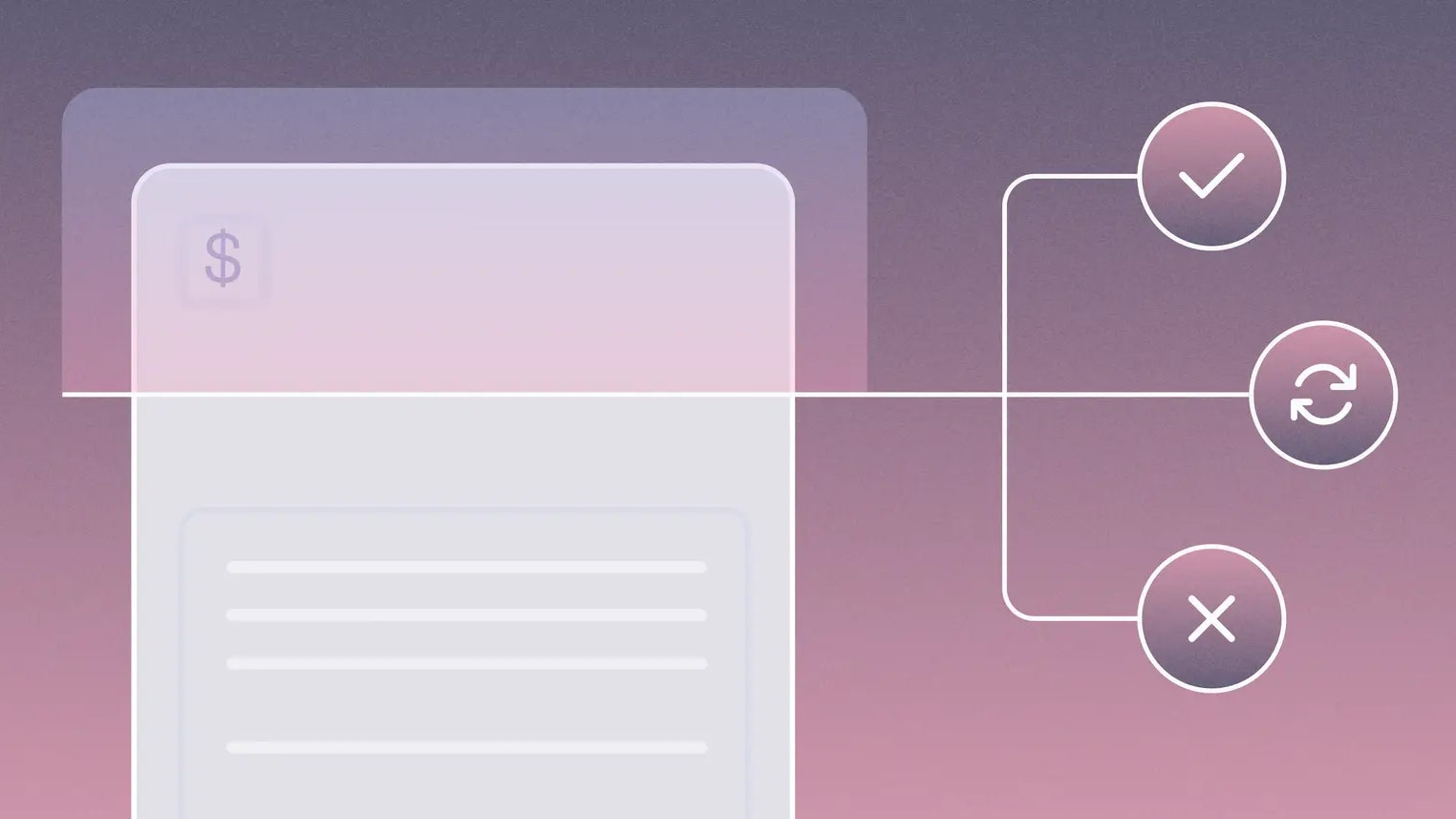Leveraging payment automation to optimize your startup’s AP processes

As a startup founder, it can be frustrating to spend time on administrative tasks like accounts payable (AP). You’re running lean and mean, and focused on building and achieving product-market fit. But getting admin things done is often critical — and paying your vendors’ invoices is a necessary part of running your business.
The accounts payable (AP) process has historically been completely manual. Various team members spend hours confirming invoice terms, matching an invoice with the related purchase order, getting necessary approvals, and ultimately paying the bill — and that time-consuming process is often prone to errors.
Now imagine completing these steps quickly, freeing you and your team to focus on what matters: growing your business. That’s one reason to consider accounts payable automation.
What is accounts payable automation?
Accounts payable automation, or AP automation, uses technology such as optical character recognition (OCR), AI, and others to automate routine accounts payable functions like invoice approval, bill payment, and periodic reconciliations.
And considering its general benefits — like speed, efficiency, and accuracy that are hard to achieve in more manual systems — it’s probably unsurprising that companies, including startups, are moving from paper-based accounts payable systems to automated ones. A recent study revealed that 77% of companies have at least partially automated their payables process.
Features of AP automation systems
While no two systems are exactly alike, the following are some common features of AP automation systems:
Automated invoice capture
AP automation systems use AI and OCR technologies to extract relevant information such as the payee's name, amount due, and vendor bank account numbers and streamline the process of inputting new invoices into your system.
Digital workflows and approvals
AP automation systems can automatically route invoices to the relevant team members for approval, reducing the need to send them notifications over Slack or via email, or to personally reach out. A good AP automation system can also send alerts and reminders, considering the invoice due date, to fast-track approvals.
Integration with ERP and accounting software
Many AP software options can integrate with your ERP and/or accounting software and automatically sync to it. Automatic syncing keeps your general ledger up to date so you can produce accurate financial reports at any time, and can alleviate the need to enter your bill in both AP/payments platforms and account software or ERPs.
Real-time tracking and reporting
Because real-time visibility characterizes AP automation systems, it’s easy to track a transaction through the payment process. A reliable AP system will also have useful dashboards that give you a bird’s-eye view into your company’s finances, helping with analysis, reporting, and decision-making.
What are the benefits of AP automation?
As a startup founder, you don’t want to just jump on bandwagons or be swayed by buzzwords—you want to use your time to achieve real results. So it’s important to fully understand the benefits your business can reap from automation solutions before implementing them in your own processes. In the case of accounts payable, here are a few potential wins:
Increased efficiency
Research shows that, on average, it takes about 11 days to process an invoice. Nearly half of companies (47%) said that invoice approvals take too long, and 45% of companies report a high percentage of exceptions and data entry errors that require review by a team member.
Being able to shave some time off means that you can reallocate hours and days to more strategic areas, like cash management and strategic planning. To further support your pursuit of speed and precision, many AP automation solutions offer efficiencies with approval workflows, document matching, data capture.
Cost savings
Every penny counts when getting a business off the ground.
The average invoice processing cost of most companies is around $13. This cost is inflated by payroll expenses downstream of the number of hours and people involved in manually processing an invoice for payment.
Companies that leverage AP automation solutions have invoice processing costs of about $3, a saving of nearly $10 per invoice. If you’re handling 1,000 invoices per month, that’s about $120,000 in costs cut per year!
(You’ll also find that some AP automation software can handle more than AP. Some offer spend management control, procurement capabilities, and cash management. By automating AP, you may be able to slim down your SaaS stack.)
Improved accuracy
If you’re manually keying and verifying invoice data, you’re likely to make a mistake, whether it’s a typo, miscalculation, or processing the same invoice twice.
By requiring your team to handle far fewer tasks manually, automation can significantly reduce common errors and inaccuracies that pop up when processing invoices. (Some AP automation solutions will also have advanced, built-in features to help minimize errors that could still crop up, such as the ability to detect and flag duplicate invoices automatically.)
Strengthened compliance and security
Whether you’re working with a bookkeeper, accountant, or full-time or fractional CFO, they have to prioritize regulatory compliance and risk mitigation—but manual or paper-based AP processes can complicate compliance.
If you have regulators or auditors reviewing your financial information, you’ll need documentation for every transaction. Automated systems can create a clear audit trail for every invoice, documenting each step from receipt to payment. This audit trail helps simplify compliance audits and provides evidence you’re following regulations.
Automated AP systems can also help ensure you’re keeping data secure and protecting accounting and financial information safe from bad actors. Many AP solutions provide security features like user access controls and data encryption to help safeguard financial information, and automations solutions should be no exception.
Enhanced visibility
In a high-volume paper-based environment, it can be virtually impossible to have an overview of all invoices in the workflow. But effective cash flow management relies on the availability of real-time, easy-to-reference data on the company’s spending and accounts payable details.
AP automation helps solve this by providing instant visibility into accounts payable via online or app-based dashboards and reporting.
Mercury’s Bill Pay, for example, ensures you receive a bill to your designated email and automatically organizes bills by approval status and due date. You can also search and filter as needed. This gives you easy ways to view and know what bills to prioritize.
Challenges with AP automation
While AP automation solutions can be incredibly beneficial to your company’s financial operations, that doesn’t mean that they’re not without their own challenges. Here are a few things to keep in mind when considering how to incorporate automation into your AP processes:
Integration issues
You want an AP automation solution that integrates well with both your ERP or accounting software. A solution that won’t play nicely with the other tools in your tech stack might be more frustrating than useful, so make it a priority to look for a solution that can seamlessly integrate with your current systems.
Automated invoice capture inaccuracies
Many AP solutions use AI and OCR technology to extract text from invoices. But these technologies aren’t flawless. Things like blurry scans, handwritten notes, or unusual fonts may cause data to transfer incorrectly or to get missed entirely when processing new invoices.
Keep in mind that OCR and AI capture data, but AP systems don’t typically verify it. Even if every piece of text on the invoice is transferred over to your AP system accurately, someone still needs to review the extracted information for accuracy.
Security and fraud prevention
Unfortunately, no technology is immune to data breaches. System vulnerabilities can expose your sensitive financial data to hackers which could lead to identity theft and financial losses.
Robust internal controls are critical to helping protect your data. For example, the team member that approves an invoice for payment shouldn’t also be the one that makes the payment—so even if a bad actor accesses one team member’s credentials, there’s a control in place to block their path forward. Get familiar with the security protocols for the AP system you’re considering. Look for two-factor or multi-factor authentication, encryption, and security audit certifications like SOC2 or ISO 27001.
And remember: following best security practices and ensuring oversight from your team is required regardless of the AP software you choose.
AP automation keys to success
While the overarching benefit of automation is that it takes a lot of the work out of AP for you and your team, you’ll still want to choose and implement your system with care and strategy — and regularly monitor it to ensure it’s serving your business as best as possible.
Here are a few best practices to ensure that your AP automation efforts serve your company well:
Know what to automate and why
Don’t just throw automation at everything and call it done. Evaluate your accounts payable processes and identify the steps that could actually benefit from automation, and those that don’t necessarily need it. You’ll need to come up with well-thought-out reasons for automating each step of the process.
Set measurable goals to track implementation success
Once you’ve set everything in motion, setting measurable goals (for instance, around cost management, user adoption and training timelines, deadlines for data migration and integration) to track and monitor implementation progress will help you spot any problems early.
Do your homework
When deciding on what AP software to buy, don’t just go with the name that first pops up on the internet. Compare options. Look for the features, security, and support you need. Learn about implementation times and the resources you’ll need to get the system up and running. (How many IT team hours will you need? Will you need outside consultants to help? And so on.)
And keep in mind that solutions aimed for large enterprises may not be the best fit for your startup — but make sure the software you select now can scale as you grow.
Plan and execute the transition
Finally, you’ll need to plan and execute the transition.
Listen to the feedback you receive throughout the research, planning, and implementation process. Address concerns that may arise about downtime and disruption or data loss during the migration. And don’t forget to prioritize buy-in from managers. Clearly and regularly communicate the need for AP automation, and help them keep it top of mind.
If you’re wondering whether it’s time to ditch the paper chase and enjoy the efficiency of AP automation, it probably is. It can help streamline your processes, cut costs, and boost accuracy. Just remember, automation is a tool — and it does its best with human oversight.
Related reads

How AI is influencing early roles at startups

Should you launch on eBay? A viability checklist by product category

The 8 most common inventory mistakes (and how to fix them)
